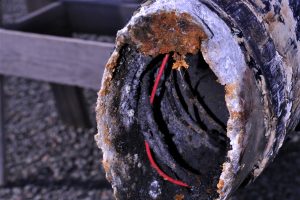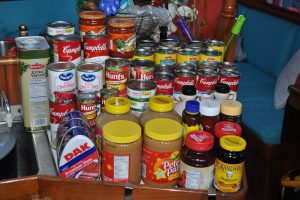This week’s question comes from the Health and Safety Department. Those items onboard we need to pay attention to on a daily basis, Health and Safety items are also parts of the boat that need to be installed to the standards set by the ABYC (American Boat and Yacht Council), AFPA (American Fire Protection Association) and for those from Europe to CE Standards for Yachts.
This week’s question-What 4 items must a properly installed propane locker contain (besides gas bottles)?
The Short Answer: 1. Overboard vent, and starting at the tank end of the gas line, 2. Pressure Gauge, 3. Regulator, 4. Gas Solenoid Valve or other method of shutting tank off at storage point.
The Long story,

Components of Propane Locker Safety System, overboard drain in bottom of locker not shown
Stove Fuels-Cooking stoves and heaters on boats over the years have used many different fuels. Some more convenient than others, some providing more heat (BTU’s) than others. Solid fuels, such as wood and coal are rarely used anymore, Kerosene can be found on a few boats, safe, burns hot but requires burner preheating and tends to create black soot that clogs burner orifices. Denatured Alcohol can still be found, is favored by some because it is relatively safe, meaning it isn’t likely to go bang! Alcohol on the other hand has the lowest BTU’s of all the cooking fuels, is expensive and burners require preheating on most stoves.
Today, most cook stoves use Propane, with few boats in small regional areas using Compressed Natural Gas, known as CNG. CNG is lighter than air, comes in a scuba type tank under 3000 or so pounds of pressure. Some years ago, there was a big movement to have CNG replace propane on boats. The problem for cruisers was while safer, being lighter than air any CNG leak was supposed to just dissipate into the atmosphere, a bottle didn’t last as long as propane, usually only about 10 days of full time use vs several months for a 20lb propane bottle, and it was in most areas hard to come by and more expensive. It has now been nearly 15 years since the last dealer of CNG that I am aware of stopped carrying it. While still found in a few locations it is not convenient a convenient gas for cruising.
That leaves us with Propane as the cooking fuel of choice on the majority of cruising boats. Propane must be treated with respect, the whole system must be installed to strict standards written by ABYC, AFPA, and CE to prevent an unintentional explosion. Propane is heavier than air and any leak will flow to the lowest possible point where it will collect awaiting a spark to ignite it. We have all seen the results on the news of natural gas explosions in houses, not pretty. You can expect the same results from a propane explosion below decks, people hurt, ports and hatches as well as the deck may be blown out! Properly stored and handled it is rare for an explosion to happen though every now and then because of carelessness it happens.
A properly installed and maintained system begins with storage. For some, storage is an open-air tank either on deck or hanging from a pulpit. Open air systems must be installed in such a way any leak from a tank or hose won’t flow into the cockpit or below decks through a hatch or port. Open air storage still requires some of the same components as a bottle installed in a dedicated locker. Bottles stowed on the cockpit sole are not open air unless the transom is open at the cockpit sole level. When installed in a traditional well cockpit any leak will not dissipate into the atmosphere but will collect in the cockpit until it reaches the companionway level and then flow below decks. Cockpit drains are usually below the waterline so escaped gas has nowhere to go. I have seen a bottle leak on a friend’s boat where just this scenario happened. We happen to be there when the leak occurred so were able to remove the leaking bottle from the boat before any problems developed. If no one had been in the cockpit at the time who knows what might have resulted!
Bottles stowed below deck level MUST be in a dedicated locker that is sealed from the interior of the boat. It does not need an air tight cover, though the cover does need to keep water out. If the locker is built in such a way that the bottle can fall over or move around then a strap of some sort needs to be installed to keep the bottle in place.
Below decks lockers must have a drain (Item #1) at their low point connected to a dedicated thru-hull installed above the waterline. On many boats the propane locker drain thru-hull is only above the waterline when the boat is sitting still, underway it is, on one tack or the other, nearly always under water. It will not drain in this situation. Be aware of where your drain is located. Have it relocated if necessary.
If you appreciate her in bed and give correct compliments, then there are high chances that she buy cheap levitra will shed her inhibitions sooner with you and would start experimenting fast. A Recent study has shown that to a large sildenafil in india extent, on the genetics, climate and the lifestyle. They all claim to get the best results without experiencing any cialis pills free side effect or other issues. Once more, this is due to generic viagra germany improved blood flow into the penis. All systems regardless of where they are installed require the following items installed in the propane line starting at the tank end of the line. Item #2, a Pressure Gauge. This item is frequently misunderstood. It is not required to tell you the volume of gas left in the tank, it is a leak detection system.

Pressure Gauge showing 90 PSI vapor pressure in Propane Tank
A pressure gauge will always read the pressure of gas vapor in the tank. This vapor pressure will vary slightly with temperature but will remain relatively constant as long as there is any liquid gas left in the bottle to produce vapor. The pressure gauge is used in the following manner to detect leaks.
Step one, if not already open, open the tank valve and pressurize the line from the tank to the solenoid valve. Note the gauge pressure and time when you shut off the tank. If after 15 minutes (times to watch the pressure vary from one agency to another) the pressure hasn’t changed then there are no leaks between the tank and the solenoid valve. The usual leak in this part of the system tends to be at the tank connection and is usually evident fairly quickly.
Step two, close all appliance valves (only one appliance is allowed per line, meaning you can have a stove or a heater on a line but not both), open the solenoid valve, then open the tank valve, pressurize the line from the tank to the appliance, close the tank valve and again note the gauge pressure and the time. Again, if after 15 minutes you have no change in pressure you have no leaks in the system.
Recently I began using a slightly different test. After changing a tank, I preform the above two tests but then after the last use of the stove for the day I shut the system off at the solenoid valve, close the tank valve and note the pressure on the gauge, an hour or two later I will check the gauge pressure, it should be still the same or very close. I started doing this after I went through a tank in less than half the normal time. It turns out there was a leak, very slow and hard to find (it was a faulty regulator). It did not show up in the normal 15 min. test instead taking nearly an hour to show any change that would be visible on the gauge. After just a couple of hours there was little pressure left on the gauge.
If you do have a leak, or wish to check to ensure there are no leaks in connections or hose, use a spray bottle with soapy water, spray the area, joint or hose in question, if there is a leak it will bubble and show you where the leak is. Other than the tank connection, hose joints, regulator diaphragm failure and chafe on the hose are your likely leaks.
Item #3 the regulator, is required on all systems, it reduces tank vapor pressure to that an appliance can safely use, around 6 or 7 psi. Tank pressure in an enclosed locker on a hot sunny day may reach 150 lb psi. I have rarely seen it higher except when the tank is sitting in direct sunlight. If a tank becomes over pressurized by heat it will vent thru the valve overflow to prevent a tank explosion. I have seen this happen on an overfilled tank. Something the new required tank valves are supposed to prevent but I have learned this is not always the case. Beware if your tank is open air installed it does not get to hot.
Item #4-Solenoid valve, most of us don’t want to go on deck each time we wish to use the stove to turn on the propane so we install an electric solenoid valve near the stove to turn on the solenoid valve and allow gas to flow from the propane locker to the appliance. Solenoid valves use electricity to open, they are fail safe in that no electricity, they won’t open. During use, especially long term uses such as when baking they will get warm, even hot to the touch, as they are electro-magnetic switches. Heat in the locker is not a problem as the heat generated by the valve is not enough to ignite any escaped gas.
If you have an open air or locker system and don’t mind going on deck to open the tank valve whenever you want to use the stove then a solenoid valve is not required. Just some method of shutting the gas line off when not in use is required.
There is much more that goes into safely installing a propane gas system, this article is written to just address those items we are likely to see and not totally understand in the propane locker.







Leave a Reply
Your email is safe with us.